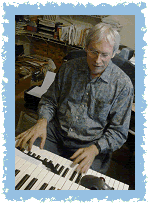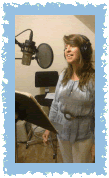Midi Magic Studio
![]()
Midi Magic Studio is a state of the art digital studio using the latest most advanced recording technology. In the late 90’s a digital revolution in the recording world replaced tape based recorders. Most professional studios have embraced this computer based technology making tape obsolete. Computer based recording is much more complex than tape, so it takes quite a commitment to keep up with the latest technology and techniques.
 I’ve been fascinated with it for years and around 1998 it really came of age with faster computers, faster and bigger hard drives, and recording software that’s stable. The benefits far outweigh any time and trouble I’ve spent building a powerful recording system. I’ve worked tape based systems for well over 20 years, so this has been very exciting witnessing the changes that computers have brought to the recording medium.
I’ve been fascinated with it for years and around 1998 it really came of age with faster computers, faster and bigger hard drives, and recording software that’s stable. The benefits far outweigh any time and trouble I’ve spent building a powerful recording system. I’ve worked tape based systems for well over 20 years, so this has been very exciting witnessing the changes that computers have brought to the recording medium.
When you record a vocal, you see the waveform on the screen and can easily do editing for individual tracks or the whole song. Some songwriters decide later on that they want to add a new section to their song. This is easily done without starting all over or like in the olden days, splicing tape.
When I record vocals I save every performance and make a compilation of the best to get the very best performance from a singer. If I hear a noise or pop, I can easily edit that out, seeing it on the screen. I can even cut and paste one word or even the “T” at the end of a word into a vocal performance or tune up the vocal if there are a few flat or sharp notes in an otherwise great performance.
 When I’m recording a midi piano part, I can see the notes come on the screen as I play them while watching a staff view, like looking at sheet music. I can easily edit out mistakes or auto-punch in spots that need to be redone.
When I’m recording a midi piano part, I can see the notes come on the screen as I play them while watching a staff view, like looking at sheet music. I can easily edit out mistakes or auto-punch in spots that need to be redone.
I also have flying faders automation. While doing a final mix the faders remember every move I make. I can sit back and watch my mixing console’s faders moving, while I listen for more things to improve the mix.
I have a full range of FX computer and hardware based: reverb, chorus, delay, flangers, leslie simulators, amp simulaters, tape simulaters, phasers, detuners, 32 band parametric EQ, compressors, limiters, gates, pitch shifters, harmonizers, auto panners,auto-tune (for tuning up off pitch vocals) plus a lot of mastering FX: Stereo enhancers, stereo compressor-limiters, aural exciters, stereo parametric EQ, room simulators.
In the past we were used to hearing studios described as being 16 track, 32 track, etc. With today’s technology I essentially have unlimited tracks for recording vocals and instruments.
My main vocal mic is a Neumann TLM 103 with a tube mic preamp. Neumann microphones are considered the best overall mic in the recording world. I use this as my main vocal mic and also for acoustic instruments. I also have a Rode NT-1, EV ND757, 2 EV DS35’s, and 2 PCM mics. I have an excellent stereo headphone system, so each vocalist and each instrumentalist will hear all the parts very clearly, which also makes them perform better. My main studio monitors are the Mackie HR824 studio reference monitor. I’ve heard more top engineers in Nashville rave about these monitors that I had to have a set. They’re crystal clear.
 My studio was built by the renowned British studio builder: Michael Cronin. It’s connected to my house, yet separate for privacy and isolation. It’s not huge, but big enough for most projects. Probably a 10 person maximum limit, any more and we would be too cramped. I have 3 isolation areas for recording a live band, a separate bathroom and lobby area.
My studio was built by the renowned British studio builder: Michael Cronin. It’s connected to my house, yet separate for privacy and isolation. It’s not huge, but big enough for most projects. Probably a 10 person maximum limit, any more and we would be too cramped. I have 3 isolation areas for recording a live band, a separate bathroom and lobby area.
I have a Yamaha SY77 synthesizer, a Yamaha P-200 88 key digital piano, an Akai 3200XL digital sampler, a Peavey SP digital sampler and about 400 CD-ROMs full of every sound imaginable from sound FX, orchestral sounds, guitars, basses, drums, percussion, samples from every synthesizer made, and many custom samples that I’ve done myself.
My main piano sound is Ivory, it streams the samples off the HD. So in essence the samples have unlimited length. When you hit a lower note on the piano the sample lasts for about 30 sec like a real piano. Each note of the piano is sampled at 12 different volumes, so that’s how you end up with a piano that uses about 30 gigabytes in samples. The end result is the most realistic digital piano I’ve ever played that feels and responds like a real piano.
I use Superior Drummer for most of my drums. I simply play the drums on the keyboard live, just like a real drummer, instead of using loops, programming patterns, or using cut and paste. This way the drums sound more spontaneous like a real session drummer instead of sterile like many preprogrammed drums. The drums were recorded with about 14 mics on several acoustic drum sets in different studios and you have total control of the room sound and bleed from each mic. The end result is a natural realistic drum sound like you’d expect from a studio drummer.
I use Vienna Instruments for most of my orchestral sounds and have many other soft synths with thousands of sounds stored on my computers in addition to my hardware samplers and synths. As you probably figured, I’m very entertained by all this technology and love what I do. The good part is you can benefit from my knowledge and expertise.
